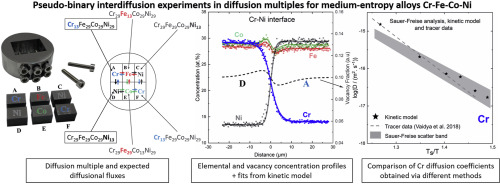当前位置:
X-MOL 学术
›
Intermetallics
›
论文详情
Our official English website, www.x-mol.net, welcomes your
feedback! (Note: you will need to create a separate account there.)
Interdiffusion in Cr–Fe–Co–Ni medium-entropy alloys
Intermetallics ( IF 4.3 ) Pub Date : 2020-07-01 , DOI: 10.1016/j.intermet.2020.106789 A. Durand , L. Peng , G. Laplanche , J.R. Morris , E.P. George , G. Eggeler
Intermetallics ( IF 4.3 ) Pub Date : 2020-07-01 , DOI: 10.1016/j.intermet.2020.106789 A. Durand , L. Peng , G. Laplanche , J.R. Morris , E.P. George , G. Eggeler

|
Abstract Diffusion in multi-component alloys is attracting renewed attention because of the worldwide interest in high- and medium-entropy alloys (HEAs/MEAs). In the present work, we used diffusion multiples made from MEAs of the quaternary Cr–Fe–Co–Ni system arranged as six distinct pseudo-binary diffusion couples (Cr29Fe13Co29Ni29–Cr29Fe29Co29Ni13, Cr29Fe29Co13Ni29–Cr29Fe29Co29Ni13, and so on, where the interdiffusing elements are italicized for clarity). In the two halves of each couple, the starting concentrations of the interdiffusing elements (Fe,Ni and Co,Ni in the above examples) were different while those of the background elements (Cr,Co and Cr,Fe in the above examples) were the same. The diffusion multiples were annealed at temperatures between 1153 and 1355 K at times from 100 to 900 h, after which the concentrations of the different elements were measured as a function of distance across each couple. Interdiffusion coefficients were derived from such concentration profiles using the standard Sauer-Freise method and compared with literature data as well as with published tracer diffusion coefficients. Although the background elements were homogeneously distributed initially, some of them developed distinct sine-wave shaped concentration gradients near the interfaces after annealing, implying that uphill diffusion of these elements had occurred. We show using a kinetic model for substitutional diffusion via vacancy hopping that such uphill diffusion can occur even in the absence of thermodynamic interactions, i.e. in ideal solid solutions in which the thermodynamic factor Φ of each element is equal to one ( Φ i = 1 + ∂ ln f i / ∂ ln c i where f i and c i are the activity coefficient and mole fraction of element i , respectively). The model accounts for all elemental fluxes and also rationalizes the diffusion profiles of the major interdiffusing elements.
中文翻译:

Cr-Fe-Co-Ni中熵合金中的相互扩散
摘要 由于全球对高熵和中熵合金 (HEAs/MEAs) 的兴趣,多组分合金中的扩散引起了新的关注。在目前的工作中,我们使用了由四元 Cr-Fe-Co-Ni 系统的 MEA 制成的扩散倍数,排列为六个不同的伪二元扩散对(Cr29Fe13Co29Ni29-Cr29Fe29Co29Ni13、Cr29Fe29Co13Ni29-Cr29Fe29Co29Ni13、为清楚起见用斜体表示)。在每一对的两半中,互扩散元素(上例中的 Fe、Ni 和 Co、Ni)的起始浓度不同,而背景元素(上例中的 Cr、Co 和 Cr、Fe)的起始浓度不同。相同。扩散倍数在 1153 至 1355 K 之间的温度下退火,时间为 100 至 900 小时,之后,测量不同元素的浓度,作为每对元素之间距离的函数。相互扩散系数是使用标准 Sauer-Freise 方法从这种浓度分布中导出的,并与文献数据以及已公布的示踪剂扩散系数进行比较。尽管背景元素最初是均匀分布的,但其中一些元素在退火后在界面附近形成了明显的正弦波形浓度梯度,这意味着这些元素已经发生了向上扩散。我们展示了通过空位跳跃使用置换扩散的动力学模型,即使在没有热力学相互作用的情况下,这种向上扩散也可能发生,即 在理想固溶体中,每个元素的热力学因子 Φ 等于 1(Φ i = 1 + ∂ ln fi / ∂ ln ci 其中 fi 和 ci 分别是元素 i 的活度系数和摩尔分数)。该模型考虑了所有元素通量,并合理化了主要相互扩散元素的扩散曲线。
更新日期:2020-07-01
中文翻译:

Cr-Fe-Co-Ni中熵合金中的相互扩散
摘要 由于全球对高熵和中熵合金 (HEAs/MEAs) 的兴趣,多组分合金中的扩散引起了新的关注。在目前的工作中,我们使用了由四元 Cr-Fe-Co-Ni 系统的 MEA 制成的扩散倍数,排列为六个不同的伪二元扩散对(Cr29Fe13Co29Ni29-Cr29Fe29Co29Ni13、Cr29Fe29Co13Ni29-Cr29Fe29Co29Ni13、为清楚起见用斜体表示)。在每一对的两半中,互扩散元素(上例中的 Fe、Ni 和 Co、Ni)的起始浓度不同,而背景元素(上例中的 Cr、Co 和 Cr、Fe)的起始浓度不同。相同。扩散倍数在 1153 至 1355 K 之间的温度下退火,时间为 100 至 900 小时,之后,测量不同元素的浓度,作为每对元素之间距离的函数。相互扩散系数是使用标准 Sauer-Freise 方法从这种浓度分布中导出的,并与文献数据以及已公布的示踪剂扩散系数进行比较。尽管背景元素最初是均匀分布的,但其中一些元素在退火后在界面附近形成了明显的正弦波形浓度梯度,这意味着这些元素已经发生了向上扩散。我们展示了通过空位跳跃使用置换扩散的动力学模型,即使在没有热力学相互作用的情况下,这种向上扩散也可能发生,即 在理想固溶体中,每个元素的热力学因子 Φ 等于 1(Φ i = 1 + ∂ ln fi / ∂ ln ci 其中 fi 和 ci 分别是元素 i 的活度系数和摩尔分数)。该模型考虑了所有元素通量,并合理化了主要相互扩散元素的扩散曲线。







































 京公网安备 11010802027423号
京公网安备 11010802027423号